Sustainable Shrimp Farming
Air Date: Week of September 13, 2013
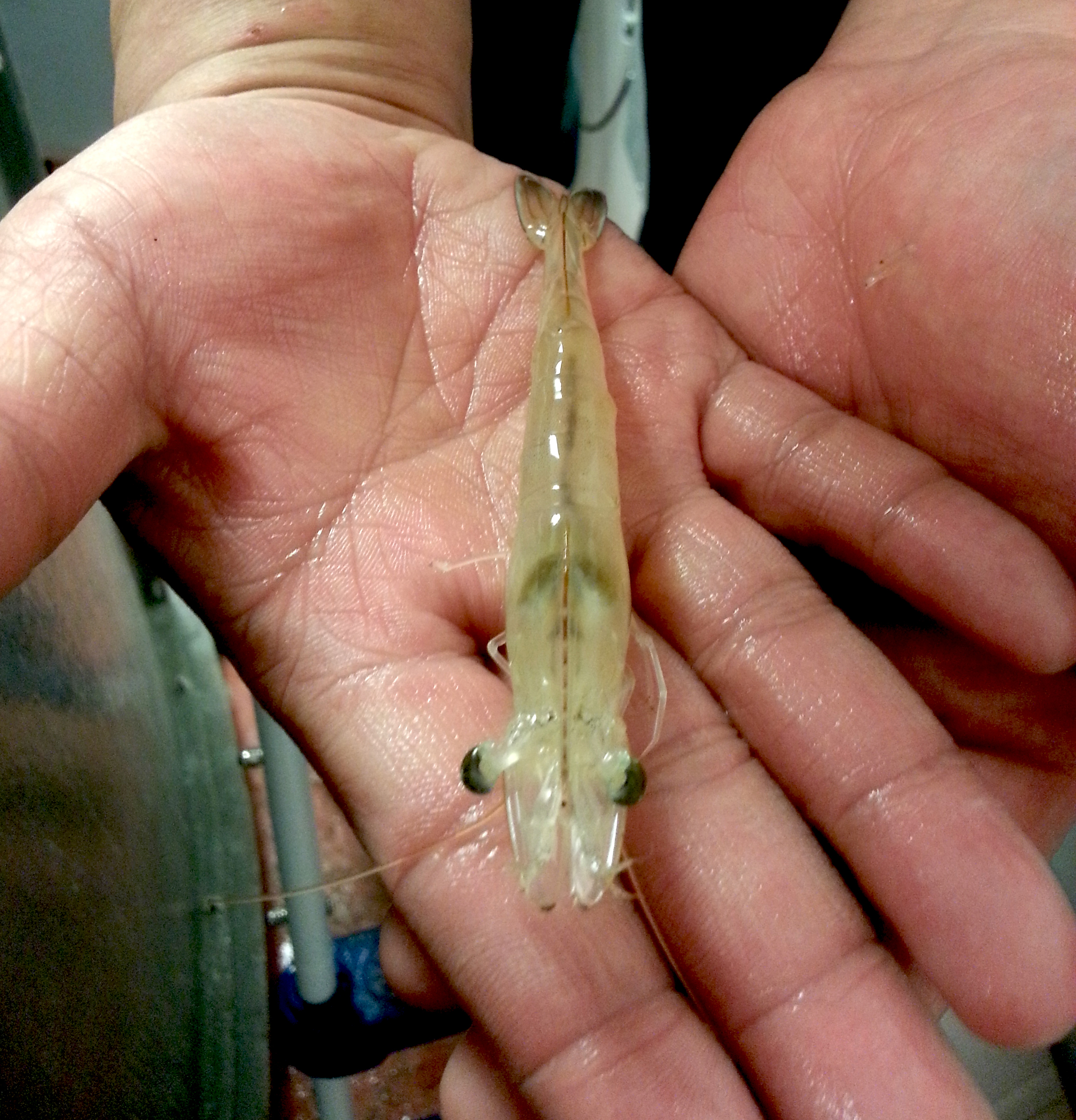
A four-month old Pacific white shrimp. (photo: Naomi Arenberg)
The United States imports over a billion pounds of shrimp annually. Most of it arrives frozen from environmentally destructive tropical farms. Now U.S. shrimp farmers are using environmentally friendly techniques to produce a fresh, delicious product with a much gentler environmental footprint. Living on Earth’s Naomi Arenberg reports.
Transcript
CURWOOD: Back in June I talked with Oceana director Andy Sharpless about his new book called The Perfect Protein, which is all about sustainable seafood. America’s favorite seafood, he said should be off-limits:
SHARPLESS: …and I’m sorry to say, you’ve got to swear off shrimp.
CURWOOD: Shrimp?
SHARPLESS: Yeah, it’s bad news, I’m sorry. There’s no way to get a shrimp and feel good about what you’re doing for the future.
CURWOOD: Virtually all the shrimp we eat is problematic - it's mostly imported frozen from Asia, and raised in environmentally damaging conditions. But now indoor shrimp farmers could turn shrimp into a “perfect protein,” delicious and sustainable. Naomi Arenberg reports from Stoughton, Massachusetts.
ARENBERG: Sky 8 Shrimp Farm is 30 miles from the ocean, and it’s easy to miss. It lies at the end of a rutted road through an industrial park, past a few 18-wheelers, in a brick building. There’s no business sign, just a small, round decal on the side door depicting a shrimp.
[WATER NOISES, SHRIMP SPLASHING]
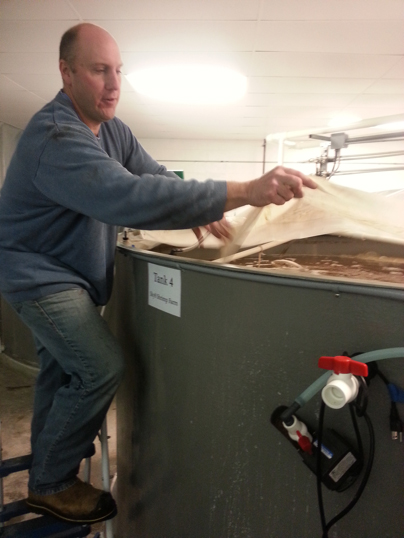
Jimmy Devine covers Tank 4 to keep the temperature at 85-degrees. (photo: Naomi Arenberg)
But past that door, behind a floor-to-ceiling plastic curtain, the clatter of water pumps, heaters, and fans takes over. There, in a half-dozen round tanks, six-feet high and 12-feet across, live several thousand Pacific White Shrimp.
TRAN: See how nice they are? Look at that…He’s about to jump..Whoa!
[LAUGHTER]
ARENBERG: Where’d he go?
TRAN: He’s right here.
ARENBERG: Poor, little shrimp!
TRAN: Very jumpy, very active.
ARENBERG: James Tran has nurtured this jumpy crop for four months, since they arrived as microscopic larvae. Now they’re a few inches long and strong enough to jump out of the net, bounce off my face, and onto the concrete floor, still wiggling. Tran gently scoops up the renegade and hands it to me.
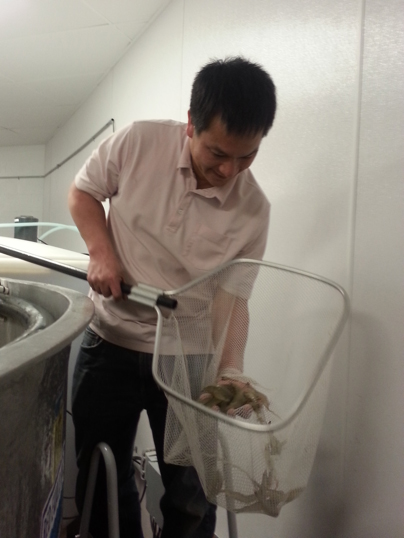
James Tran shows off his four-month-old Pacific white shrimp (Latin: vannamei) (photo: Naomi Arenberg)
TRAN: There you go.
ARENBERG: It’s like a piece of stained glass. You can practically see through him.
TRAN: Very beautiful type of animal, and we can do this 365 days per year, regardless of weather. If you growing shrimp out in the sun, it’s really hard to control temperature, but within the controlled environment like this warehouse I always set my temperature at 85-degree.
ARENBERG: The farm is Tran’s brainchild, and it was all built by his partner, contractor Jimmy Devine.
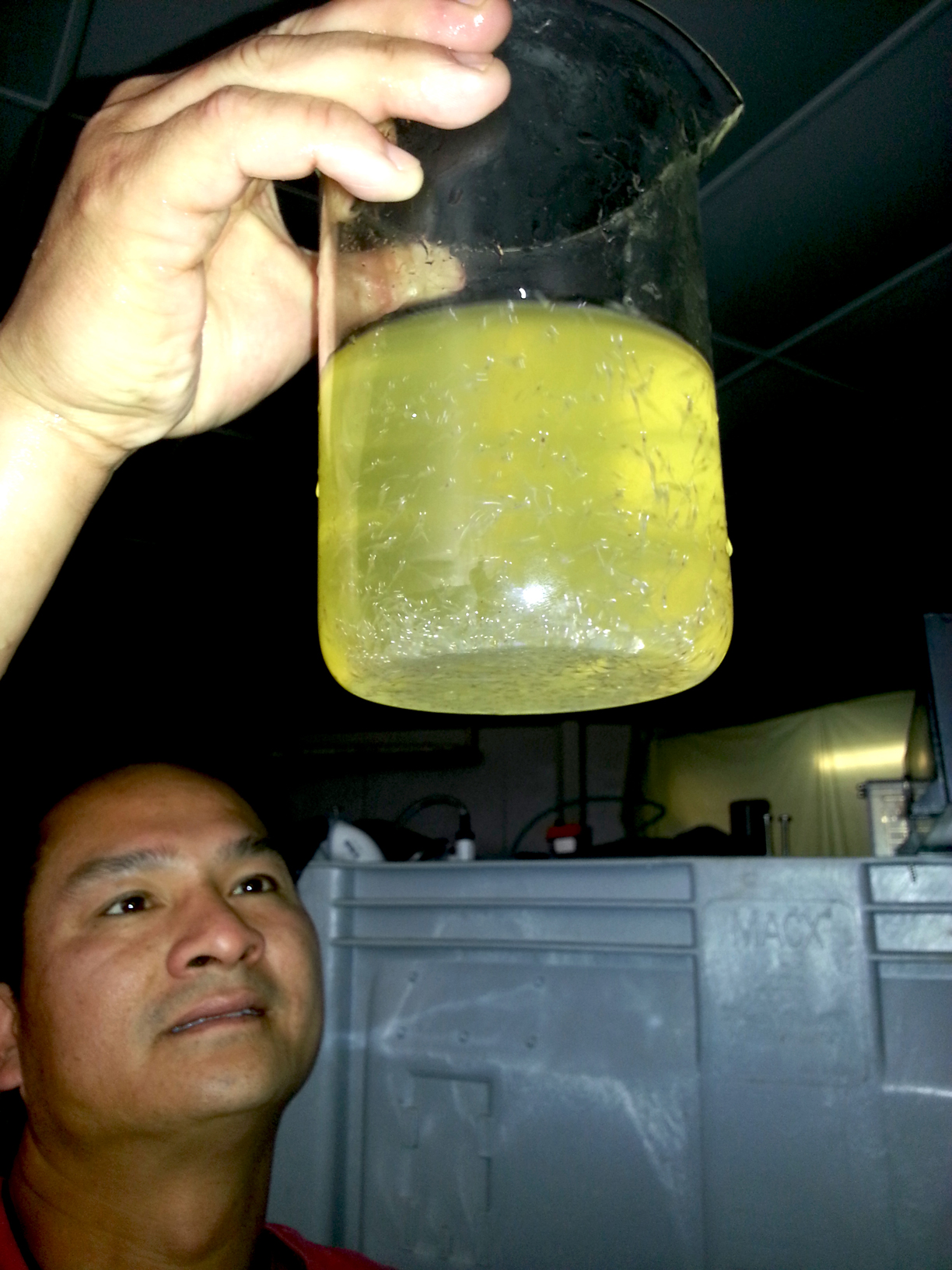
James Tran holds up a beaker of shrimp larvae, just two weeks old. (Naomi Arenberg)
DEVINE: There’s zero coastline impact. There’s no discharge.
ARENBERG: Jimmy says that’s another benefit of an indoor operation.
DEVINE: All we do is take the water from the ocean and bring it here. And then after three years we sample the water to make sure it has the proper minerals and solid things that are in there and then continue to use it. So, it’s very environmentally friendly.
ARENBERG: Before we head out of the noisy tank room, James and Jimmy drape a sheet of heavy plastic over the tank. Then they dim the lights.
[PLASTIC CURTAIN RUSTLING]
ARENBERG: You seem very loving toward your shrimp. Do you feel as though you’re putting them to sleep, saying, “Good night?”
DEVINE: You should meet Tone, the other guy that’s not here right now. He takes care of ‘em like they’re his baby. When we put ’em to market, we’re gonna have to ask Tone to go outside while we bring ’em to the store. Yes, he loves them..If he was allowed to swim in the tank with them, I guess he’d get in.
[LAUGHTER]
ARENBERG: Tone, the caretaker, is from Laos, James Tran's from Viet Nam, their consultant is in the Netherlands. Jimmy Devine and the marketing specialist are from the Boston area. Tran’s international team has created something unique in New England, the region’s first shrimp farm. Permitting took several months as state officials had to find their way through an entirely new process. Now the Sky 8 facility’s complete. In the office Tran explains how he maintains his water quality.
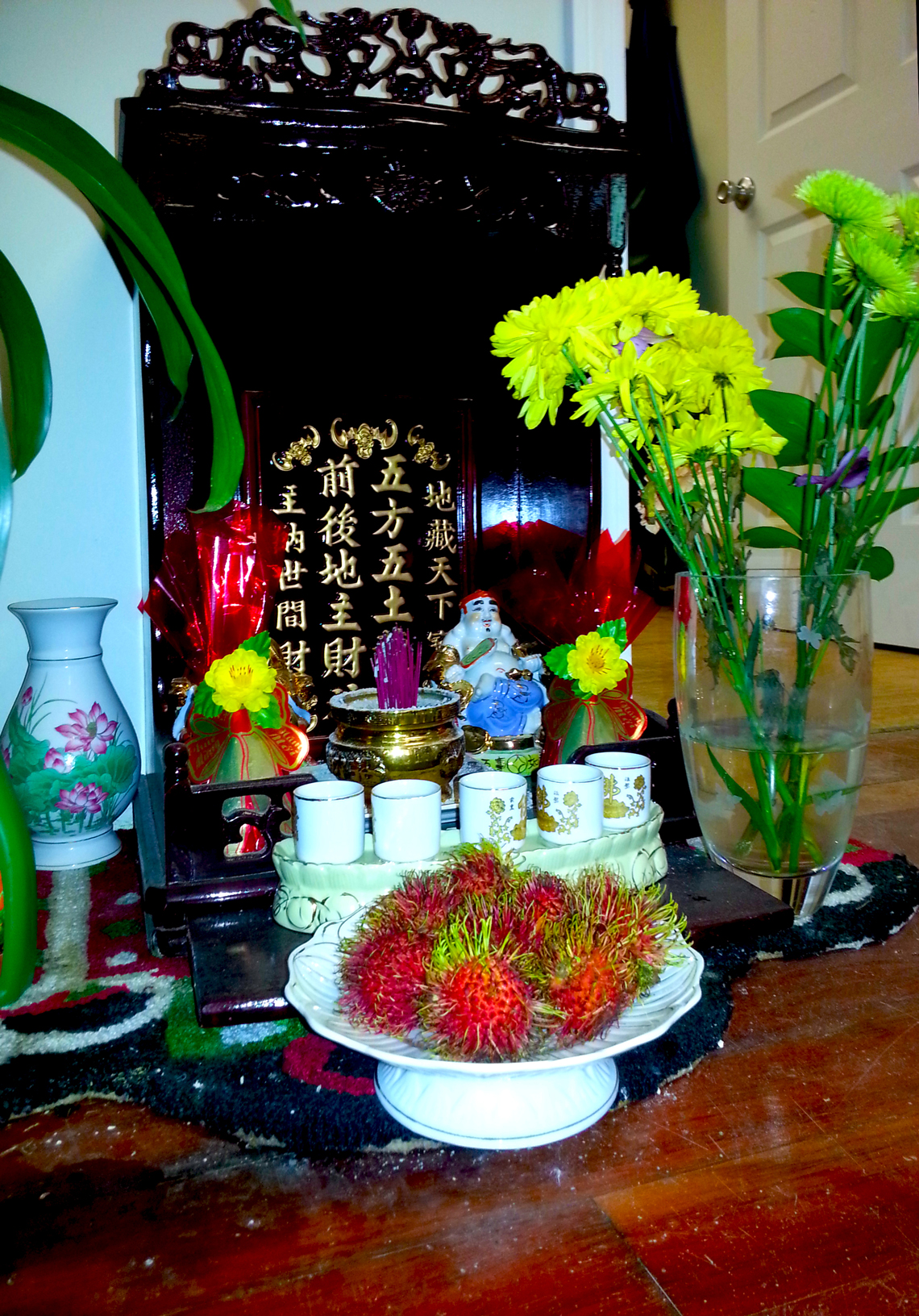
Just inside Sky 8 there's a shrine, typical of East Asian businesses. (photo: Naomi Arenberg)
DEVINE: The idea of this project is we using recirculating aquaculture system. It’s a biofloc system. Biofloc, it just a bacteria. It’s also a protein for the shrimp. It does two things. It’s a protein, but it is a bacteria to consume the solid of the shrimp.
ARENBERG: Experts from National Oceanic and Atmospheric Administration describe biofloc as a community of microscopic organisms, that can include bacteria, algae, crustaceans, and nematodes, and that form a colony. The colony takes in nutrients from the water and turns them into protein and fat which the shrimp eat, along with an occasional pellet of shrimp feed. In turn, the biofloc community consumes the shrimp waste. This symbiotic relationship keeps the water clean and cuts the cost of feed. Tran says the system also provides a bonus perk for the farmer.
TRAN: Probably one year later we will empty it, and, using that flocs, using that waste, you can use that for plant fertilizer. Yeah, I can sell that too. [LAUGHS]
ARENBERG: Tran’s brother is a shrimp farmer back in Vietnam. A couple of years ago Tran, who’s an electrical engineer, was researching equipment for his brother. The more James read about Southeast Asian aquaculture, which is based outdoors, the more interested he got in improving it.
TRAN: I will not suggest to the American people to eat shrimp from import because it’s too dangerous. They use antibiotic, they use chemical. They can raise the shrimp to reach market size, 20, 21, 22 gram, within two months. Mine takes how many months?
ARENBERG: His take much longer - five to six months.
TRAN: Because I don’t use any antibiotic or anything like that. It’s just 100 percent natural.
ARENBERG: And shrimp farmers’ dependence on chemical additives is not restricted to East Asia. Darryl Felder is a crustacean researcher at the University of Louisiana. He says commercial shrimp farming standards globally are low.
FELDER: This is certainly not organic gardening. This is a very technologically intense application of pesticides in order to favor the harvesting of shrimp.
ARENBERG: And Professor Felder says that outdoor shrimp farms alter the environment significantly.
FELDER: The most common, traditional ones and the ones that are propagate the most rapidly to this day are those that utilize coastal, low-lying lands near shore, and often they have been covered with mangroves, and they are tidally floodable. The entrepreneurs that step in to build the shrimp farms will clear the mangroves, and they’ll dig shallow ponds, and then they will stock those ponds with juvenile shrimp that they’ve purchased from a hatchery, they have ’em flown in, and then they’ll feed them over a period of time, using foods that consist often heavily of fishmeal.
ARENBERG: Removing the coastal mangroves destroys both a natural nursery for young fish and crustaceans and protections from storms and coastal erosion. And that’s not all…
FELDER: The effluent from those ponds is having very negative impacts on natural estuaries that may have previously sustained artisanal fisheries for local, indigenous populations. What everyone has hoped for is to get away from that, and to get to something that is a little more self-contained, that recycles the water and yet that produces a very good product.
ARENBERG: That’s just what Tran and Devine are trying to do in New England. As well as building a closed system with no discharge, they’re tackling the feed issue. Traditional fishmeal pellets are made primarily from small fish that never grow up to be harvested for people to eat. The Sky 8 partners are working on their own food formula, which will save on fishmeal and money. Their commitment to environmental responsibility already is paying off, with a number of area restaurants serving Sky 8 shrimp.
COOPER: My name is Eric Cooper. I am the chef at 10 Tables in Provincetown, Massachusetts. We basically run a very seasonal menu with a strong focus on using local produce.
ARENBERG: 10 Tables is an upscale restaurant with locations in metropolitan Boston as well as this one, at the outer tip of Cape Cod. Chef Eric says that his customers have commented on the Massachusetts-raised shrimp he serves.
COOPER: The reaction generally has been very positive. They love the flavor, and a lot of people have commented on how excited they are to be getting shrimp that are, you know, farmed in Stoughton - it’s kind of a funny idea, Stoughton is land-locked, you know?

The only sign on Sky 8 Shrimp Farm's door is a depiction of a shrimp. (photo: Naomi Arenberg)
ARENBERG: A funny idea, perhaps, but the fact that these shrimp are so fresh and local affects affects their taste as well as their environmental footprint.
COOPER: These shrimp are very, very soft and delicate in texture. The flavor is very, very clean. It’s just this magnificent, sweet, pure shrimp flavor, and they are beautiful, like almost translucently clear. Nobody thinks of fish coming from farms, everybody assumes it’s wild-caught, and that’s not something we can do for much longer. I guess, as a chef, it’s something that I try to focus on, I like to make sure that the seafood we’re using is something that we’re not going to be eating the last of.
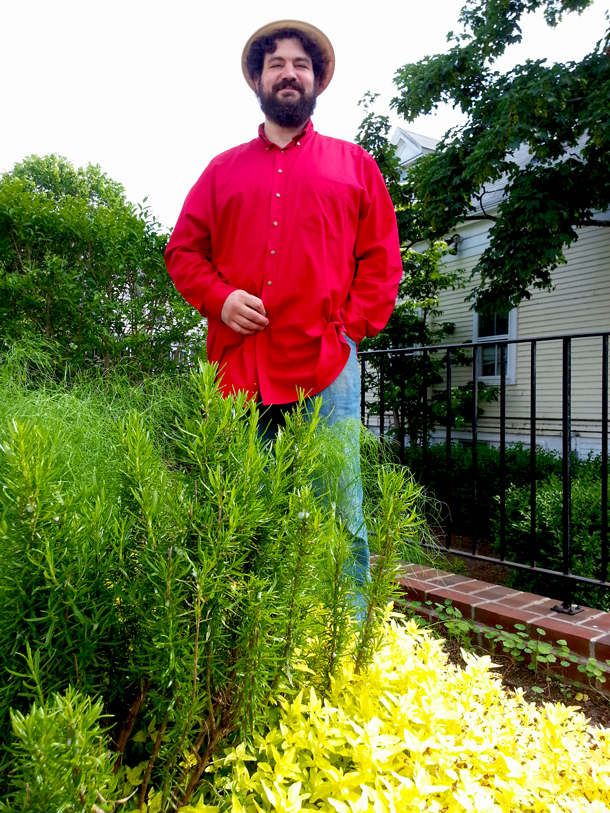
Chef Eric Cooper in the garden at Ten Tables in Provincetown. (photo: Naomi Arenberg)
ARENBERG: Eric Cooper is part of a movement among chefs who want fresh, local seafood. James Tran says that both Whole Foods Market and East Coast-based Legal Sea Foods asked for exclusive rights to the Sky 8 product, but he turned them down. He feels there’s more quality control with his shrimp in the hands of an individual chef who values the eating experience of his clients, rather than in the vault of a large food operation, even a well-respected one. And now this new farm is gaining wider notice. Barton Seaver is a renowned chef and author, whose work focuses on sustainable ingredients. He has a long and impressive title.
SEAVER: Director of the Healthy and Sustainable Food Program at the Center for Health and Global Environments at Harvard University’s School of Public Health.
ARENBERG: Seaver holds up sky 8 as a model for shrimp farming.
SEAVER: It is mimicking natural systems in ways that are smart, intuitive, and based on ingenuity, and, I think, really represents a great step forward. They’re not just farming shrimp; they’re farming a host of cultures and bacteria and shrimp that act in concert to bring both good economy and good, delicious products to market.
ARENBERG: He says, while biofloc shrimp are more expensive than their tropical cousins that come in frozen, the superior flavor and environmental profile of these fresh shrimp have value.
SEAVER: I think that we need to alter our definition of ‘affordable’ because we spend less on food than any other developed nation in the world. And I think when we broaden the definition of ‘affordable,’ when we broaden the definition of ‘sustainable,’ to ask, ‘What is that we’re trying to sustain?’…Well, the answer is ourselves, our community, our lives, our reality. And so I think that what Sky 8 is doing is very much in line with these principles, in that they’re creating huge value beyond the calories, you know, that we can count with every meal.
ARENBERG: Sky 8 owner James Tran is counting on consumers to recognize that value as well as the potential for broader impact on the economy. He says that the United States outsources billions of dollars every year on imported shrimp.
[SFX SKY 8’S TANK ROOM]
TRAN: My goal and my hope is to build not just only here but other state, because I wanna create job for American people, bring it back here. It’s ridiculous, when we live in one of the world most advanced in technology, and we cannot raise shrimp? Come on, that’s not right. Therefore, I make a determination to push this business as far as I could.
ARENBERG: It’s too early to know exactly how far this business could go. But if his vision becomes reality, then in a few years the menu in your neighborhood restaurant could feature locally grown, sustainable shrimp.
For Living on Earth, I’m Naomi Arenberg in Stoughton, Massachusetts.
CURWOOD: There’s more at our website, LOE.org.
Links
Sky 8 Shrimp Farm in Stoughton, MA
Marvesta Shrimp Farm in Maryland is another “green” operation.
Information about Barton Seaver’s work
Living on Earth wants to hear from you!
Living on Earth
62 Calef Highway, Suite 212
Lee, NH 03861
Telephone: 617-287-4121
E-mail: comments@loe.org
Newsletter [Click here]
Donate to Living on Earth!
Living on Earth is an independent media program and relies entirely on contributions from listeners and institutions supporting public service. Please donate now to preserve an independent environmental voice.
NewsletterLiving on Earth offers a weekly delivery of the show's rundown to your mailbox. Sign up for our newsletter today!
 Sailors For The Sea: Be the change you want to sea.
Sailors For The Sea: Be the change you want to sea.
 The Grantham Foundation for the Protection of the Environment: Committed to protecting and improving the health of the global environment.
The Grantham Foundation for the Protection of the Environment: Committed to protecting and improving the health of the global environment.
 Contribute to Living on Earth and receive, as our gift to you, an archival print of one of Mark Seth Lender's extraordinary wildlife photographs. Follow the link to see Mark's current collection of photographs.
Contribute to Living on Earth and receive, as our gift to you, an archival print of one of Mark Seth Lender's extraordinary wildlife photographs. Follow the link to see Mark's current collection of photographs.
 Buy a signed copy of Mark Seth Lender's book Smeagull the Seagull & support Living on Earth
Buy a signed copy of Mark Seth Lender's book Smeagull the Seagull & support Living on Earth

